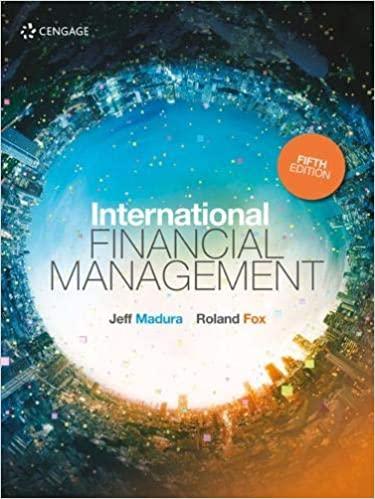Question
Beryl's Iced Tea currently rents a bottling machine for $50,000 per year, including all maintenance expenses. It is considering purchasing a machine instead, and is

Beryl's Iced Tea currently rents a bottling machine for $50,000 per year, including all maintenance expenses. It is considering purchasing a machine instead, and is comparing two options: A. Purchase the machine it is currently renting for $155,000. This machine will require $22,000 per year in ongoing maintenance expenses. B. Purchase a new, more advanced machine for $265,000. This machine will require $15,000 per year in ongoing maintenance expenses and will lower bottling costs by $12,000 per year. Also, $37,000 will be spent upfront training the new operators of the machine.Suppose the appropriate discount rate is 9% per year and the machine is purchased today. Maintenance and bottling costs are paid at the end of each year, as is the rental of the machine. Assume also that the machines will be depreciated via thestraight-line method over seven years and that they have aten-year life with a negligible salvage value. The marginal corporate tax rate is 30 %: Should Beryl's Iced Tea continue torent, purchase its current machine, or purchase the advancedmachine? To make this decision, calculate the NPV of the FCF associated with each alternative. (Note: the NPV will benegative, and represents the PV of the costs of the machine in each case.)
A bicycle manufacturer currently produces 277,000 units a year and expects output levels to remain steady in the future. It buys chains from an outside supplier at a price of $2.10 a chain. The plant manager believes that it would be cheaper to make these chains rather than buy them. Direct in-house production costs are estimated to be only $1.50 per chain. The necessary machinery would cost $239,000 and would be obsolete after ten years. This investment could be depreciated to zero for tax purposes using a ten-year straight-line depreciation schedule. The plant manager estimates that the operation would require $53,000 of inventory and other working capital upfront (year O), but argues that this sum can be ignored since it is recoverable at the end of the ten years. Expected proceeds from scrapping the machinery after ten years are $17,925. If the company pays tax at a rate of 20% and the opportunity cost of capital is 15%, what is the net present value of the decision to produce the chains in-house instead of purchasing them from the supplierStep by Step Solution
There are 3 Steps involved in it
Step: 1

Get Instant Access to Expert-Tailored Solutions
See step-by-step solutions with expert insights and AI powered tools for academic success
Step: 2

Step: 3

Ace Your Homework with AI
Get the answers you need in no time with our AI-driven, step-by-step assistance
Get Started


